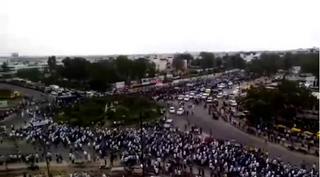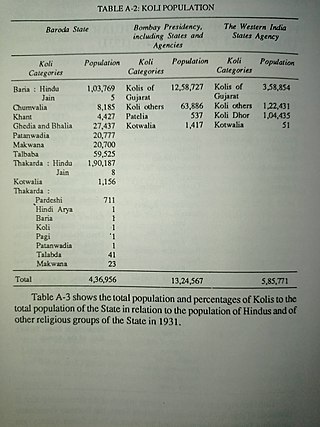Related Research Articles
Patel is an Indian surname or title, predominantly found in the state of Gujarat, representing the community of land-owning farmers and later businessmen, agriculturalists and merchants. Traditionally the title is a status name referring to the village chieftains during medieval times, and was later retained as successive generations stemmed out into communities of landowners. There are roughly 500,000 Patels outside India, including about 150,000 in the United Kingdom and about 150,000 in the United States. Nearly 1 in 10 people of Indian origin in the US is a Patel.
Parmar, also known as Panwar or Pawar, is a Rajput clan found in Northern and Central India, especially in Rajasthan, Gujarat, Punjab, Haryana, Uttarakhand, Uttar Pradesh, Bihar, Madhya Pradesh and North Maharashtra. The Panwar ruled in Ujjain and later in Dhar.
The Khasia, or Khasiya is a clan (Gotra) of the Koli caste found in the Indian state of Gujarat. The Mahuva was the stronghold or controlled by Khasia Kolis but they were defeated by the Thakur Wakhatsinhji of Bhavnagar State and their controlled Territories of Mahuva, Kundla, Rajula, Gadhada and Botad. Khasiya Kolis were pirates in Gujarat ocean and lived by piracy.

Patidar, formerly known as Kanbi, is an Indian land-owning and peasant caste and community native to Gujarat. The community comprises at multiple subcastes, most prominently the Levas and Kadvas. They form one of the dominant castes in Gujarat. The title of Patidar originally conferred to the land owning aristocratic class of Gujarati Kanbis; however, it was later applied en masse to the entirety of the Kanbi population who lay claim to a land owning identity, partly as a result of land reforms during the British Raj.
Garasia alternatively spelled Girasia, Girasiya or Garasiya, is a title used by tribal chieftains and members of other arms bearing lineages in India who held the villages as Giras granted by rulers.
The Gujarat Kshatriya Sabha was a social organisation in the Indian state of Gujarat which was initiated to get together the Kolis and Rajputs of the state. Gujarat Kshatriya Sabha was started by a Koli Jagirdar Natvarsinh Solanki and a Rajput Mahendrasinh Mahida to resolve the problems faced by both communities and to be in power at political level. The Gujarat Kshatriya Sabha was most important for Rajputs to be in power at political level because they were only 4% of the total population of Gujarat while Kolis were largest caste cluster comprising the 24% of total population of state.
Jethwa is a clan of Rajputs and Koli castes of Gujarat. Jethwa surname is also found among Darji, Mistris of Kutch, and Gurjar Kshatriya Kadias castes of Gujarat.
Jhala is a Rajput clan. They are found in Rajasthan and Gujarat state of India. The clan is also found among Koli castes as Jala.

The Pateliya, or Patelia or Patel is a landowning Subcaste of Koli caste found in the Indian states of Gujarat. During the British Raj in India, Patelia Kolis served as tax collectors and administrators. The name Patelia comes from a word meaning village chief. Many Patelia Kolis also went into business and commerce during the Raj period. Patelia Kolis are part of Talapada Kolis of Gujarat.

The Rathva or Rathwa is a Subcaste of the Koli caste found in the Indian state of Gujarat. Rathava Kolis were agriculturist by profession and turbulent by habits but now lives like Adivasis such as Bhil because of their neighborhood
The Kotwal also spelled as Cotwal, or Kotval, was a title used in medieval and early modern period for the leader of a Kot or fort. Kotwals often controlled the fort of a major town or an area of smaller towns on behalf of another ruler. It was similar in function to a British Indian Zaildar From Mughal times the title was given to the local ruler of a large town and the surrounding area. However, the title is also used for leaders in small villages as well. Kotwal has also been translated as Chief police officer. The post of Kotwal was known since ancient times as Kota pala who was the chief of Police.
The Vala, or Wala is a Gujarati clan (Gotra) mostly found among Koli, Rajput and Kathi castes of Gujarat.

The Baria Koli, or Baraiya Koli, Bareeya Koli and Bariya Koli is a clan (Gotra) of the Koli caste found in the Indian State of Gujarat and Dadra and Nagar Haveli and Daman and Diu. the Devgad Baria was their Stronghold or given their name to Baria State in Gujarat.

The Koli is an Indian caste found in Rajasthan, Himachal Pradesh, Gujarat, Maharashtra, Uttar Pradesh, Haryana, Karnataka, Odisha and Jammu and Kashmir states in India. Koli is an agriculturist caste of Gujarat but in coastal areas they also work as fishermen along with agriculture. In the beginning of 20th century, the Koli caste was recognised as a denotified tribe under Criminal Tribes Act by the Indian Government because of their anti-social activities during World War I.

The Mewasi, or Mevasi, Mehwasi is a title of Koli caste found in Indian state of Gujarat. The Koli chieftains who ruled over villages populated by turbulent Kolis were titled as Mewasi because of their rebellious activities against Maratha and Mughal rulers.

Morvi State, also spelled as Morvee State or Morbi State, was a princely salute state in the historical Halar prant (district) of Kathiawar during the British Raj.

Surgana State was a princely state of the Bombay Presidency during the era of the British Raj. It was the only state belonging to the Nasik Agency. Its capital was Surgana in Nashik District of present-day Maharashtra. It was ruled by Kolis of Pawar dynasty.

The Chunvalia Koli, or Chuvalia Koli, Chunwalia Koli is a subcaste of the Koli caste, found in the Indian state of Gujarat. The Chunvalia Kolis were the first Indian caste to adopt the game of cricket in India. Chunvalia Kolis were classified as a Criminal Tribe under Criminal Tribes Act by government of the British Raj because of their purported anti-social behaviour and activities, such as alleged dacoity in Gujarat. During the First World War, Chunwalia Kolis were enlisted as soldiers in British Indian Army by the Bombay government of British India.

The Talapada Koli, or Talpada Koli, is a subcaste of the Koli caste of Gujarat state in India. Talapada Kolis are agriculturists by profession. they were members of the Gujarat Kshatriya Sabha, an organisation launched by Natwarsinh Solanki who was a Koli elite. In 1907, they were classified by the British as a Criminal Tribe, ascribing to them a range of anti-social activities such as highway robbery, murder, and theft of animals, cattle and standing crops. They were also alleged to be blackmailers and hired assassins.
The Chauhan Koli is a clan of the Koli caste living in the Gujarat and Rajasthan states in India.
References
- ↑ Lobo, Lancy (1995). The Thakors of North Gujarat: A Caste in the Village and the Region. New Delhi, India: Hindustan Publishing Corporation. p. 163. ISBN 978-81-7075-035-2.
- ↑ Shah, A. M. (2012-12-06). The Structure of Indian Society: Then and Now. New Delhi, India: Routledge. p. 168. ISBN 978-1-136-19770-3.
- ↑ Franco, Fernando; Macwan, Jyotsna; Ramanathan, Suguna (2000). The Silken Swing: The Cultural Universe of Dalit Women. India: Sangam Books Limited. p. 21. ISBN 978-81-85604-41-1.
- ↑ Shah, A. M. (2002). Exploring India's Rural Past: A Gujarat Village in the Early Nineteenth Century. New Delhi, India: Oxford University Press. p. 82. ISBN 978-0-19-565732-6.
- ↑ Roy, Shibani (1983). Koli Culture: A Profile of the Culture of Talpad Vistar. Delhi, India: Cosmo Publications. p. 151.
- ↑ Jain, Jyotindra (1980). Folk Art and Culture of Gujarat: Guide to the Collection of the Shreyas Folk Museum of Gujarat. India: Shreyas Folk Museum of Gujarat; Shreyas Prakashan. p. 133.
- ↑ Tambs-Lyche, Harald (1997). Power, Profit, and Poetry: Traditional Society in Kathiawar, Western India. India: Manohar Publishers & Distributors. p. 130. ISBN 978-81-7304-176-1.
- ↑ Silverberg, James (1962). Peasant Behavior and Its Caste-relevancy: The Kolis of Kasandra. India: University of Wisconsin. pp. 31–32, 152.
- ↑ Kohli, Atul (2014-07-14). India's Democracy: An Analysis of Changing State-Society Relations. New Delhi: Princeton University Press. p. 266. ISBN 978-1-4008-5951-1.
- ↑ Kanjamala, Augustine (1996). Integral Mission Dynamics: An Interdisciplinary Study of the Catholic Church in India. New Delhi, India: International Publications. p. 156. ISBN 978-81-85574-15-8.
- ↑ Uberoi, Patricia (1994). Family, Kinship and Marriage in India. India: Oxford University Press. p. 139. ISBN 978-0-19-563508-9.
- ↑ Clark, Alice Whitcomb (1979). Central Gujarat in the Nineteenth Century: The Integration of an Agrarian System. Gujarat, India: University of Wisconsin--Madison.